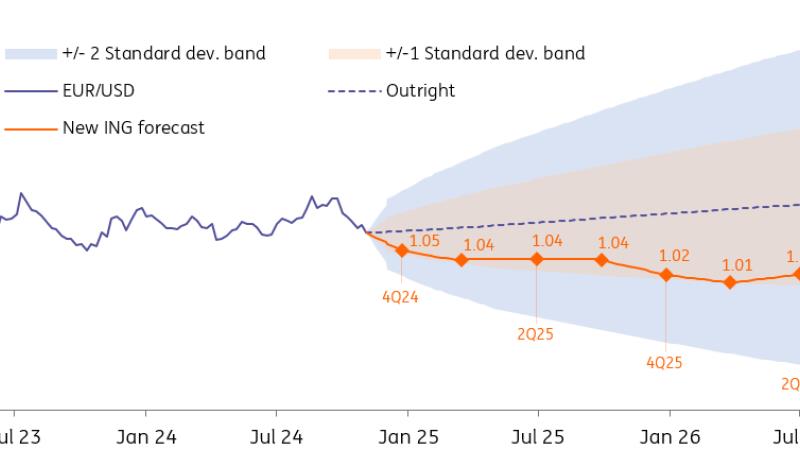
New President, New EUR/USD Forecasts
This 2024 US election always looked like a very binary event for the FX market. Now that the Republicans have secured both the White House and very likely Congress, we can expect a lower profile for EUR/USD. This largely reflects our pre-election assessment of the global and domestic consequences of a Trump clean sweep, as well as some updated views on the path for ECB and Fed rates.
Our new EUR/USD projections
Two key building blocks for the view
While there are many structural factors which go into exchange rate forecasting, two of the most fundamental are interest rate spreads and a risk premium. The former can determine asset preferences for financial institutions or hedging costs for corporate treasurers. The latter risk premium is a gauge of how far exchange rates can deviate from financial fair value driven by uncertainty. This is particularly important for the incoming Trump Presidency.
As discussed frequently in our election scenario previews, the likely Republican clean sweep and the prospect for renewed fiscal stimulus have re-priced the Fed landing rate higher. Short-dated USD OIS swap rates priced two years forward rose 15bp in Asia on election day as the Republican success became clear. Instead of the sub-3% terminal rate for the Fed easing cycle expected by the market in September, our team now sees the Fed cutting rates more slowly in 2025 to end at a terminal rate of 3.75%.
What was a little surprising on election day was how quickly the market moved to price a deeper ECB easing cycle. We agree that the prospects of US protectionism in 2025 make it more likely that the ECB will cut rates by 50bp in December this year. And we see a terminal rate of 1.75% in 2025 – perhaps as early as the second quarter of next year – as European policymakers take rates into slightly accommodative territory.
Creating a two-year swap rate differential profile from those central bank views, we see this influential spread staying wide near the 200bp over the next two years. Looking solely at the relationship between EUR/USD and that rate spread over the last 12 months points to EUR/USD not straying too far from 1.05 over the next two years. But now we have to add the risk premium.
Adding in the risk premiumOver the last 10 years, we have calculated that EUR/USD can deviate some +/-5% from short-term financial fair value – that fair value is largely determined by interest rate spreads. The task now – in creating a EUR/USD forecast profile – is to estimate the timing of when that risk premium hits.
Speaking to our country and trade economists, we factor in a peak risk premium being priced into EUR/USD in 4Q25/1Q26. Why pick those quarters? We chose this period because it should take about a year for President-in-waiting Trump's trade team to file trade investigations with the WTO or to conduct internal investigations at the US Trade Representative. That was the case with tariffs enacted against China in 2018.
4Q25/1Q26 could prove 'peak pressure' for Europe as the Trump team seeks to secure trade or other concessions from Europe, while tight financial conditions (the US ten-year Treasury yield could be as high as 5.50% around this time) could contribute to softening the risk environment and adding pressure to the pro-cyclical EUR/USD. Our European team feels that the timing sits well with a view that a cohesive support package for domestic demand in Europe only emerges later in 2026 rather than in 2025.
Bringing the rate differential and risk premium story together produces a profile where EUR/USD trades lower than it does now for the next two years. We think it will probably be knocking on parity's door by late 2025.
Upside risks to this profile stem from either Chinese or European policymakers surprising with sufficient fiscal stimulus (a new German government could play a role here ) to move the needle on global demand trends. Or a buyers' strike of US Treasuries triggering financial dislocation and ultimately lower Fed policy rates. Downside risks – probably more in 2026 – stem from a eurozone recession in response to tariffs (a very difficult environment for investment) and the ECB needing to cut rates much more deeply.

Legal Disclaimer:
MENAFN provides the information “as is” without warranty of any kind. We do not accept any responsibility or liability for the accuracy, content, images, videos, licenses, completeness, legality, or reliability of the information contained in this article. If you have any complaints or copyright issues related to this article, kindly contact the provider above.






















Comments
No comment